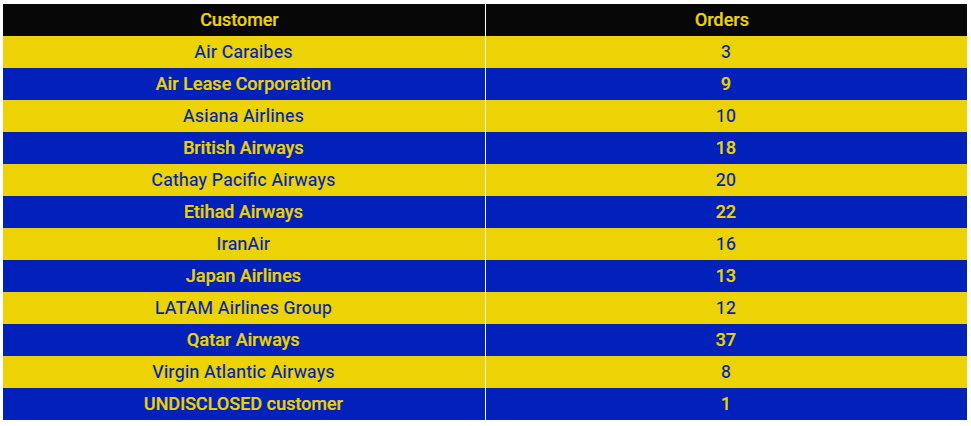Summary:
- Airbus A350-1000 secure Type Certification from European Aviation Safety Agency (EASA) and the US Federal Aviation Administration (FAA).
- Airbus has 169 firm orders for the largest member of the A350XWB family from 11 customers.
- Analysts believe aircraft has moved from a "mainline to niche" airliner as marketplace and boardroom outlooks have changed in past five years.
The A350-1000's seven-metre-longer fuselage boosts capacity to 366 passengers in a standard three-class configuration, around 40+ more seats than the A350-900, and according to Airbus responds to market needs for larger cabin zones with premium-type seats. With a similar range and high commonality to its smaller sister, Airbus says the new variant is well suited for some of the airline industry's busiest long-haul routes, but are customers starting to thaw to the appeal of the airliner.
To date 11 customers from five continents have ordered a total of 169 A350-1000s but as a recent Insights analysis from CAPA - Centre for Aviation suggests the aircraft may be arriving at the market at the wrong time as airline board's start to take a more risk averse outlook and perhaps look at the conservative solution of deploying smaller capacity aircraft.
This is based partly upon decisions by the likes of Cathay Pacific Airways and United Airlines to switch orders from the -1000 to the smaller -900 variant. Hong Kong-based Cathay Pacific had been the flag bearer for the programme when it converted an existing -900 commitment and placed an additional order for the -1000 at the Farnborough Air Show back in 2012- then CEO John Slosar had described the variant as an "irresistible proposition".
However, fast forward five years and Cathay Pacific has now converted six of its 26 -1000s to -900s, while United Airlines has swapped all of its 35 1000s for 45 A350-900s. As CAPA notes, the A350-1000 has moved from "mainstream to niche," and potentially to be an asset they can minimise or trade away to strengthen other segments in their fleets.
While CAPA acknowledges that the fleet changes at Cathay Pacific and United "do not invalidate the A350-1000 or condemn it to oblivion before it even commences commercial service," they do indicate "there has been change in the lineup of new aircraft, developments with in-service fleet, and evolving global markets where new aircraft are deployed".
It is clear that since the A350-1000 was launched the 777X has become a more attractive proposition to the world's airlines with the 777-9 considered a better fit for premium, large markets once thought to be core opportunities for the A350-1000. "Compared to the A350-1000, the 777-9 is viewed by airlines to have more range, and to be able to carry more passengers (and cargo) at the right cost," says CAPA. In fact it identifies that in the case of United the A350-1000 is already being impacted by the 777X's predecessor the 777-300ER.
TABLE- Airbus currently has firm orders for 169 A350-1000s from eleven customers Source: The Blue Swan Daily and CAPA Fleets Database
Source: The Blue Swan Daily and CAPA Fleets Database
Airbus highlights that the high commonality between the -1000 and -900 will bring benefits to operators of both types. More than half of the major A350 XWB customers have ordered both the -1000 and the shorter-fuselage -900 versions. Qatar Airways is the prime example with a commitment for 37 -1000s alongside 39 -900s. Others include Asiana Airlines, Japan Airlines, LATAM Airlines and Etihad Airways, albeit the latter's order could be seen as in a little doubt as it revises its business strategy and it has also committed to the 777X.
It was at the peak of the market that Airbus relaunched the A350-1000 and accumulated most orders for it and while we would expect an inevitable post-peak cycle, we are also seeing changes in the marketplace that could make it harder and harder to place the aircraft with customers. Of course, it could be a case that the aircraft has arrived too early. Japan Airlines, an early customer for the 777-300ER is replacing its aircraft with the A350-1000 and we could perhaps see customers of younger 777-300ERs turning to the Airbus model in the future when they consider fleet renewal.
As CAPA notes, markets once thought to be ideal for the A350-1000 have become "more obviously suited to the 777X, or even the older - and cheaper - 777-300ER,"but also, more significantly, a structural adjustment within airline management "to be more risk averse" could see "downgauging to smaller aircraft".
With clouds hanging over the A380 programme, Airbus will be keen to avoid another slow selling aircraft programme. The line between success and failure for the A350-1000 ahead of its commercial debut may be unclear, but with combined bookings for 858 aircraft from 45 customers as of 31-Oct-2017, it is clear the A350 as a programme is, and will continue to be, a popular line with the world's airlines.
READ THE FULL ANALYSIS: A350-1000 order changes: pragmatism prevails as airlines become more risk-averse